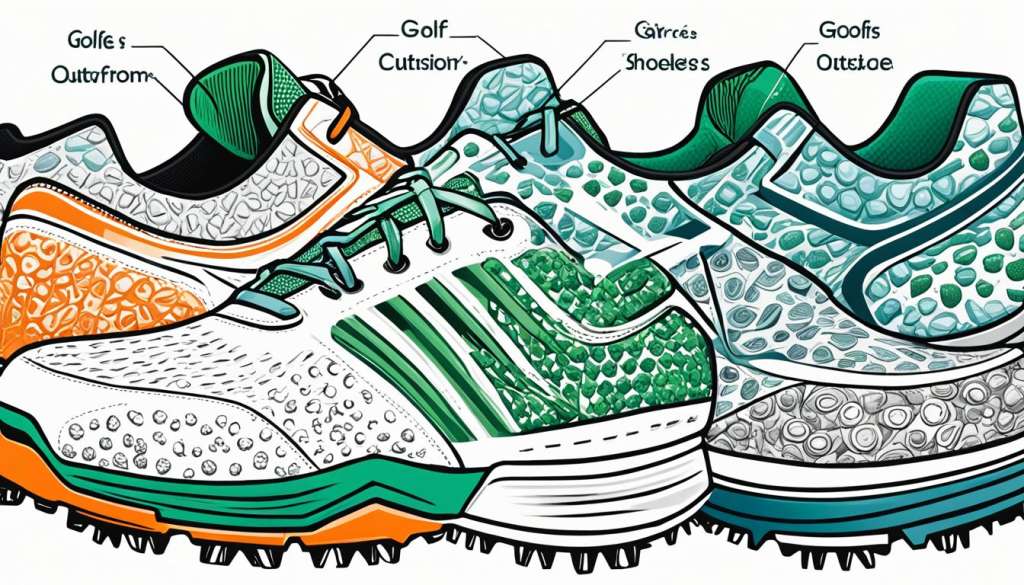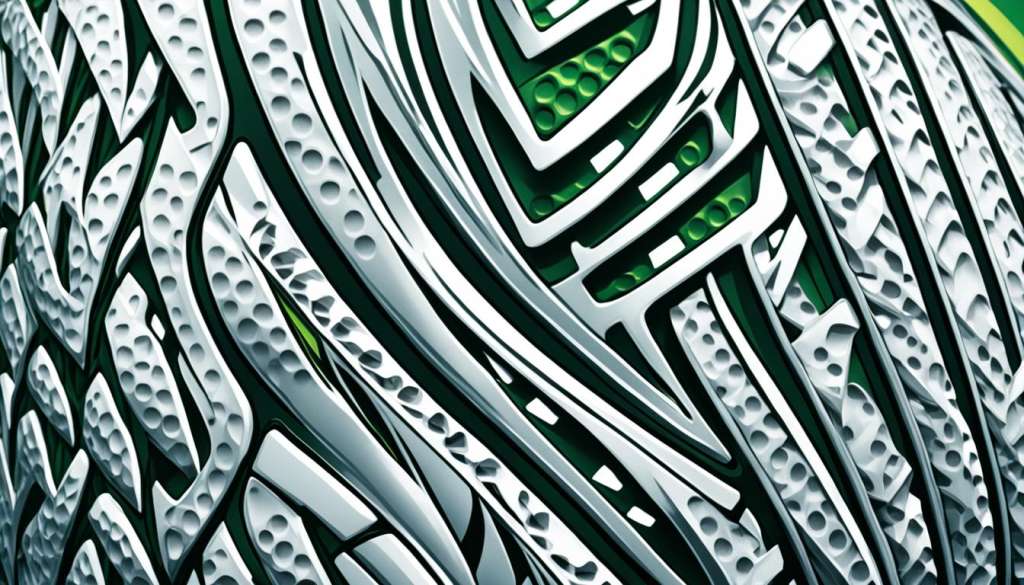Understanding golf shoe traction systems can boost your game. The right golf shoe grip is key for staying stable during your swing and handling different course conditions. The right outsoles can greatly affect your performance on the green.
Golf shoes have special traction systems for stability and grip. These systems include cleats, spikes, or both. They help you stay grounded while swinging, preventing slips and improving control.
Whether you’re new to golf or have been playing for years, the traction on your golf shoes matters. It’s not just about feeling comfortable. It’s about trusting your technique without worrying about slipping.
This guide will cover the different types of golf shoe traction systems, their advantages, and how to pick the best one for you. You’ll discover the latest in golf shoe technology and how to keep your shoes in top shape for the course.
Understanding the Importance of Golf Shoe Traction
Golf shoe traction is key to your game’s success. The right grip can change your game, affecting your swing and safety. Let’s explore why traction patterns are so important.
Impact on Swing Stability
Your golf swing begins with your feet. Golf shoe spikes or traction patterns give you a stable base. This lets you transfer power effectively into the ball.
With the right traction, you stay balanced during your swing. This leads to more consistent shots.
Role in Preventing Slips and Falls
Golf courses have different terrains and conditions. From wet grass to steep slopes, your shoes need good grip. Good traction lowers the chance of slipping during your swing or walking.
This safety feature is key for a worry-free game of golf.
Influence on Overall Performance
The right golf shoe traction can improve your game. It lets you tackle tough lies and weather with confidence. You’ll feel secure on crucial shots or driving off the tee.
Better traction means less energy spent on balance. This lets you focus on your technique and strategy.
| Traction Type | Stability | Slip Prevention | Performance Impact |
|---|---|---|---|
| Spiked | High | Excellent | Significant improvement |
| Spikeless | Moderate | Good | Noticeable improvement |
| Hybrid | High | Very Good | Substantial improvement |
Understanding these aspects of golf shoe traction will help you pick the right shoes. The perfect balance of stability, safety, and performance can greatly improve your golfing experience.
Types of Golf Shoe Traction Systems
Golf shoe traction systems are key to your performance on the course. There are two main types: spiked and spikeless golf shoes. Each type has its own benefits for different playing styles and course conditions.
Spiked golf shoes have replaceable cleats on the outsoles. These give you the best grip and stability, especially on wet or hilly grounds. The spikes go deep into the ground, helping you during your swing and while walking.
Spikeless golf shoes have flat outsoles with small nubs or lugs. They are versatile, letting you wear them on and off the course. They might not grip as well as spiked shoes in tough conditions, but they’re comfy and good for dry, flat courses.
Some brands now offer hybrid models. These shoes mix the stability of spikes with the comfort of spikeless shoes. They try to give you the best of both worlds.
| Feature | Spiked Golf Shoes | Spikeless Golf Shoes |
|---|---|---|
| Traction | High | Moderate |
| Versatility | Limited to course use | Can be worn on/off course |
| Comfort | Good | Excellent |
| Ideal Conditions | Wet, hilly terrain | Dry, flat courses |
| Maintenance | Regular spike replacement | Minimal |
Your choice between spiked and spikeless golf shoes depends on your playing style, the course, and what you prefer. Think about these factors when picking the right traction system for your game.
Spiked Golf Shoes: Traditional Traction
Spiked golf shoes have been a key part of the sport for a long time. They give golfers the grip they need on different course surfaces. These shoes have cleats or spikes that can be replaced. This lets you adjust the grip to fit your style and the course.
Metal Spikes vs. Soft Spikes
There are two main kinds of golf shoe spikes: metal and soft. Metal spikes give a strong grip but are not used much because they can harm the course. Soft spikes, made of tough plastic, are now the top choice for most golfers and courses.
| Spike Type | Traction | Course Impact | Comfort |
|---|---|---|---|
| Metal Spikes | Excellent | High | Moderate |
| Soft Spikes | Very Good | Low | High |
Advantages of Spiked Golf Shoes
Spiked golf shoes have many benefits:
- Superior grip on wet or muddy courses
- Excellent stability during powerful swings
- Ability to replace worn spikes
- Customizable traction patterns
Considerations for Different Course Conditions
Think about the usual conditions of the courses you play when picking spiked golf shoes. If you often play on damp or muddy courses, spiked shoes are a great choice. It’s important to replace the spikes regularly to keep your shoes working well, especially on tough courses.
Spiked golf shoes are great for grip but might not be as flexible as spikeless shoes. They’re not as comfy for everyday wear, but they perform best in tough playing conditions.
Spikeless Golf Shoes: Modern Versatility
Spikeless golf shoes have changed the game with their sleek design and versatility. They combine the comfort of athletic shoes with the grip needed for golf. This makes them a favorite among golfers at every level.
These shoes stand out with their flat outsole and small nubs or lugs. This design gives you grip without spikes. It also means they’re flexible and breathable, making your game more comfortable.

One big plus of spikeless golf shoes is how versatile they are. You can wear them on and off the course without needing different shoes. This has made them a hit with both casual and serious golfers.
While they might not grip as hard as spiked shoes, they’re great for dry conditions. For most players, the grip is enough, especially on well-kept courses.
| Feature | Spikeless Golf Shoes | Traditional Spiked Shoes |
|---|---|---|
| Traction | Moderate | High |
| Comfort | High | Moderate |
| Versatility | High (on/off course) | Low (course only) |
| Weight | Lighter | Heavier |
| Durability | Variable | High |
New materials and designs are always making spikeless golf shoes better. Companies are working on improving their traction patterns. This means you get better grip in different conditions, helping you swing smoothly.
Golf Shoe Traction Systems Guide
Golf shoe traction systems are key to your game. They help you stay stable, prevent slipping, and boost your performance. Let’s explore the main parts of golf shoe outsoles and how to pick the best for grip.
Evaluating Traction Patterns
When picking golf shoes, check the outsole design closely. Different patterns work for different swings and course types. Choose patterns that give a good grip in all parts of your swing.
Material Considerations for Outsoles
The material of golf shoe outsoles impacts their durability, flexibility, and grip. Rubber is often used for its good grip and comfort. Some shoes use special materials for grip in wet and dry conditions, ensuring a steady grip all round.
Customizable Traction Options
Many golf shoes now have customizable traction. You can change spike settings or replace old spikes easily. This makes your shoes last longer and lets you adjust your grip to the course or your liking.
| Traction Type | Advantages | Best For |
|---|---|---|
| Spiked | Maximum grip, stability | Wet conditions, uneven terrain |
| Spikeless | Versatility, comfort | Dry conditions, casual play |
| Hybrid | Balanced performance | All-around play, varying conditions |
Understanding these aspects of golf shoe traction systems helps you choose better. This can improve your stability and performance on the golf course.
Factors Affecting Traction Performance
Your golf shoe grip is key to your game. Many things affect how well your shoes stick to the ground. Let’s look at what makes a difference and how to get the best grip.
What the course is like changes how your shoes stick. Wet grass needs different grip than dry ground. Hills require more grip than flat spots. Your swing style also plays a part. If you move a lot during your swing, you’ll need stronger grip to stay balanced.
Different shoes have different grip patterns. Rubber outsoles are good for most surfaces. TPU (thermoplastic polyurethane) is durable and flexible. Some shoes mix materials for the best grip.
| Factor | Impact on Traction |
|---|---|
| Moisture | Reduces grip, requires deeper treads |
| Terrain | Uneven surfaces need more aggressive patterns |
| Temperature | Extreme heat can soften outsoles, affecting grip |
| Wear and Tear | Reduces effectiveness over time |
Weather also changes how well your shoes stick. Rain makes it harder to grip, and heat can make outsoles soft. Keeping your shoes clean after each game and replacing worn parts helps them perform better.
Maintaining and Replacing Golf Shoe Traction
Keeping your golf shoe traction systems in top shape is key for great performance on the course. Regular maintenance and timely replacements help you keep a solid grip throughout your game.
Cleaning Techniques for Optimal Grip
After each round, clean your golf shoes to keep their traction. Use a soft brush to remove dirt and debris from the outsoles. For tough grime, warm water and mild soap are great. Make sure to dry your shoes well to avoid moisture damage.
When to Replace Spikes or Cleats
You should replace your golf shoe spikes when you notice they’re not gripping well or when you see wear. Check your spikes often and replace them if they’re worn down, loose, or missing. Most golfers need new spikes every 15-20 rounds, based on how much you play and the course conditions.
| Signs for Replacement | Frequency |
|---|---|
| Reduced Traction | Every 15-20 rounds |
| Visible Wear | Inspect after each round |
| Loose or Missing Spikes | Replace immediately |
DIY Traction Enhancement Methods
Here are easy ways to boost your golf shoe grip:
- Use a spike wrench to tighten loose cleats
- Apply grip-enhancing sprays to the outsole
- Install aftermarket traction kits for extra grip
- Roughen smooth areas on spikeless shoes with sandpaper
By taking care of your golf shoe traction systems, you’ll get better stability and performance. Regular care and replacing spikes when needed will help you stay steady on the greens, no matter the course conditions.
Innovations in Golf Shoe Traction Technology
Golf shoe traction technology has made big strides in recent years. Companies are working hard to make golf shoe outsoles that give you a better grip and stability. These new features aim to boost your performance on the course, no matter the weather or the ground.

Now, we’re seeing advanced materials in golf shoe outsoles. Engineers create materials that are both light and strong, giving you great traction. These materials move with your foot, making sure you stay in contact with the ground during your swing.
Hybrid traction systems are becoming more popular among golfers. They mix the stability of spiked shoes with the ease of spikeless shoes. This means you get the best grip and flexibility for different course conditions.
Smart traction systems are a new big thing in golf shoe grip tech. They change their grip based on the terrain you’re on. So, whether you’re on the tee, fairway, or green, the shoe adjusts to give you the best grip.
- Customizable traction options allow you to fine-tune your golf shoe grip
- Eco-friendly materials are being used in golf shoe outsoles
- 3D-printed soles offer unique traction patterns for improved stability
As golf shoe traction technology keeps getting better, we’ll see more new features. These will help improve your game and make playing more comfortable.
Choosing the Right Traction System for Your Game
Finding the perfect golf shoe traction system can greatly improve your game. It’s a choice between spiked and spikeless golf shoes based on your playing style and preferences.
Think about the terrain you usually play on. If you often play on wet or hilly courses, spiked golf shoes are better. They give you a strong grip, keeping you stable during your swing and preventing slips.
For those who want versatility, spikeless golf shoes are great. They’re comfortable for both playing and walking off the course. These shoes work well in dry conditions and on flat ground, perfect for golfers with varied playing conditions.
Your swing style is key in choosing the right traction. Golfers with an aggressive swing might prefer spiked shoes for extra stability. If you swing smoothly or like a natural feel, spikeless shoes could be better.
| Factor | Spiked Golf Shoes | Spikeless Golf Shoes |
|---|---|---|
| Terrain | Wet, hilly | Dry, flat |
| Grip Level | High | Moderate |
| Versatility | Course-specific | On and off course |
| Swing Style | Aggressive | Smooth |
Try out different golf shoe traction systems to see what works best for you. The right choice can make you more confident and improve your performance on the green.
Conclusion
Golf shoe traction systems are crucial for your game. They improve your stability, comfort, and overall performance. When choosing golf shoes, consider the courses you play on, your swing style, and what feels good on your feet.
Whether you prefer classic spiked shoes or newer spikeless ones, the right grip can enhance your game. Make sure to clean your golf shoes often and replace worn parts to keep the traction. Your golf shoe grip greatly affects your performance, so think about it carefully.
As technology advances, we’ll see more exciting changes in golf shoe performance. These advancements will offer more ways to improve your footing and play better golf. By picking the right traction system for your needs, you’re setting yourself up for success on the green.

